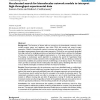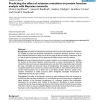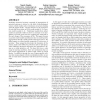148 search results - page 20 / 30 » The evolutionary capacity of protein structures |
BMCBI
2007
13 years 7 months ago
2007
Background: The functions of human cells are carried out by biomolecular networks, which include proteins, genes, and regulatory sites within DNA that encode and control protein e...
BMCBI
2006
13 years 7 months ago
2006
Background: A number of methods that use both protein structural and evolutionary information are available to predict the functional consequences of missense mutations. However, ...
ATAL
2006
Springer
13 years 11 months ago
2006
Springer
Modeling dynamical systems composed of aggregations of primitive proteins is critical to the field of astrobiological science, which studies early evolutionary structures dealing ...
BMCBI
2008
13 years 7 months ago
2008
Background: Prediction of disulfide bridges from protein sequences is useful for characterizing structural and functional properties of proteins. Several methods based on differen...
BMCBI
2008
2008
WSPMaker: a web tool for calculating selection pressure in proteins and domains using window-sliding
13 years 7 months ago
Background: In the study of adaptive evolution, it is important to detect the protein coding sites where natural selection is acting. In general, the ratio of the rate of non-syno...



